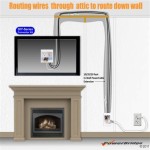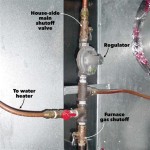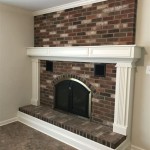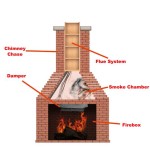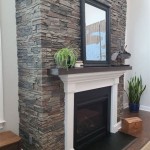Fireplace Frames and Doors: Enhancing Functionality and Aesthetics
Fireplace frames and doors represent essential components for many fireplace systems, contributing significantly to both their functional performance and aesthetic appeal. Selecting the appropriate frame and door set requires careful consideration of various factors, including fireplace type, size, material, style, and specific functional requirements. Understanding these elements ensures the chosen components effectively complement the fireplace system and enhance the overall ambiance of the space.
The primary purpose of a fireplace frame is to provide a finished, decorative border around the fireplace opening. It conceals the rough edges of the firebox and adjacent wall materials, creating a clean and visually appealing transition. The frame also serves as a mounting point for fireplace doors, ensuring a secure and stable installation. Fireplace doors, in turn, offer several advantages. They control airflow, preventing drafts and heat loss when the fireplace is not in use. They also contain sparks and embers, enhancing safety and reducing the risk of fire hazards. Furthermore, doors can improve the overall efficiency of the fireplace by regulating combustion and directing heat into the room.
Key Point 1: Understanding Frame Materials and Styles
Fireplace frames are available in a wide range of materials, each offering distinct characteristics in terms of durability, aesthetics, and cost. Common materials include:
Cast Iron: Cast iron frames are known for their robust durability and classic, timeless appeal. They are highly resistant to heat and can withstand the rigors of frequent use. Cast iron frames are often adorned with intricate designs and patterns, adding a touch of elegance to the fireplace. However, they can be relatively heavy and may require professional installation.
Steel: Steel frames offer a balance of strength, affordability, and versatility. They are lighter than cast iron, making them easier to handle and install. Steel frames can be powder-coated or painted in a variety of colors to match the decor of the room. Stainless steel options provide enhanced corrosion resistance for fireplaces exposed to moisture.
Aluminum: Aluminum frames are lightweight, corrosion-resistant, and relatively inexpensive. They are a good choice for contemporary fireplace designs where a sleek, minimalist look is desired. Aluminum frames are easy to maintain and can be anodized or painted in a range of finishes.
Wood: Wood frames offer a warm and inviting aesthetic. They can be crafted from various types of wood, such as oak, maple, or cherry, and stained or painted to complement the surrounding decor. Wood frames are best suited for fireplaces that are not frequently used, as they are susceptible to heat damage and require special care.
Stone: Stone frames, such as marble, granite, or slate, provide a luxurious and sophisticated look. They are highly durable and resistant to heat. Stone frames can be custom-cut to fit any fireplace opening and offer a unique and timeless appeal. However, they are typically the most expensive option and require professional installation.
The style of the fireplace frame should complement the overall architectural design of the room. Traditional styles often feature ornate details and classic motifs, while contemporary styles emphasize clean lines and minimalist designs. Consider the existing decor and choose a frame that enhances the fireplace's visual appeal without overwhelming the space.
Key Point 2: Exploring Fireplace Door Types and Functionality
Fireplace doors are available in various styles and configurations, each offering different levels of functionality and aesthetic appeal. Common types include:
Bifold Doors: Bifold doors consist of two or more panels that fold inward when opened, maximizing the viewing area. They are a popular choice for their ease of use and unobtrusive design. Bifold doors are available in both framed and frameless styles, allowing for customization to suit different fireplace aesthetics.
Sliding Doors: Sliding doors glide horizontally along a track, offering a smooth and effortless operation. They are a good choice for fireplaces with limited space in front of the opening. Sliding doors are typically made of tempered glass and can be single-panel or multi-panel designs.
Single Panel Doors: Single panel doors consist of a single sheet of tempered glass that swings open like a traditional door. They offer a clean and unobstructed view of the fire. Single panel doors are often used in contemporary fireplace designs where simplicity and minimalism are desired.
Bi-Fold Trackless Doors: These doors feature a system where the doors fold and stack away from the firebox opening, providing a full view and simple operation without a clunky track system. These models are often favored for their sleek look and ease of use.
Mesh Screen Doors: Mesh screen doors provide a barrier against sparks and embers while allowing for maximum airflow. They are a popular choice for those who enjoy the crackling sound and warmth of an open fire. Mesh screen doors are typically made of woven metal and can be installed as a standalone screen or integrated into a framed door system.
The functionality of fireplace doors extends beyond simply containing sparks and controlling airflow. Doors can also significantly improve the energy efficiency of the fireplace. When closed, they prevent drafts and heat loss up the chimney, reducing heating costs. Some doors are equipped with heat-resistant gaskets that create a tight seal, further minimizing heat loss. Additionally, doors can regulate combustion by controlling the amount of air entering the firebox, allowing for more efficient and cleaner burning.
Consider the type of fuel used in the fireplace when selecting doors. Gas fireplaces typically require doors with ventilation to ensure proper combustion. Wood-burning fireplaces may benefit from doors with adjustable air vents that allow for precise control over the fire's intensity. Always consult with a qualified fireplace professional to ensure the chosen doors are appropriate for the specific fireplace system.
Key Point 3: Installation and Maintenance Considerations
Proper installation is crucial for ensuring the safe and efficient operation of fireplace frames and doors. While some homeowners may attempt DIY installation, professional installation is generally recommended, especially for complex systems or heavy materials. A qualified fireplace installer will ensure that the frame is properly aligned and securely mounted, and that the doors are properly aligned and sealed.
Before installation, carefully measure the fireplace opening to ensure that the frame and doors are the correct size. The frame should fit snugly against the surrounding wall, and the doors should open and close smoothly without any obstructions. It is also important to ensure that the fireplace is properly cleaned and inspected before installing the frame and doors. Any cracks, gaps, or other damage should be repaired to prevent air leaks and ensure structural integrity.
Regular maintenance is essential for prolonging the life of fireplace frames and doors and maintaining their optimal performance. Clean the frame and doors regularly with a mild soap and water solution to remove dust and debris. Avoid using harsh chemicals or abrasive cleaners, as these can damage the finish. Inspect the doors for any signs of damage, such as cracks, chips, or broken hinges. Replace any damaged components promptly to prevent further deterioration.
For doors with glass panels, use a specialized glass cleaner designed for fireplaces to remove soot and creosote buildup. These cleaners are formulated to dissolve stubborn deposits without damaging the glass. Avoid using abrasive cleaners or scouring pads, as these can scratch the glass. Inspect the door seals and gaskets regularly for any signs of wear or cracking. Replace worn seals and gaskets to maintain a tight seal and prevent air leaks.
Finally, have the fireplace and chimney professionally inspected and cleaned annually to ensure that they are functioning safely and efficiently. A qualified chimney sweep will remove any creosote buildup in the chimney, which can pose a fire hazard. They will also inspect the fireplace for any signs of damage or deterioration and recommend any necessary repairs.
By carefully considering the materials, styles, and functionality of fireplace frames and doors, and by following proper installation and maintenance procedures, homeowners can enhance the beauty and efficiency of their fireplaces while ensuring a safe and comfortable living environment.
Selecting the right fireplace frame and doors involves a careful assessment of the fireplace's dimensions, the desired aesthetic, and the required functionality. A well-chosen frame and door set can transform a fireplace from a simple heating appliance into a focal point of the room, adding warmth, elegance, and value to the home.
Ultimately, the key is to choose frames and doors that not only enhance the aesthetic appeal but also improve the safety and efficiency of the fireplace, ensuring years of enjoyment and reliable performance.

Standard Size Masonry Fireplace Doors Fixed Frame

Glass Fireplace Doors Stoll Industries Browse By Type Or Style

Fireplace Glass Doors Vs Screens Full Service Chimney

You Ll Love The Simplicity Of This Riveted Screen With Its Handy Sliding Doors Metal Frame Features Riv Fireplace Screens

Manhattan Fireplace Door By Stoll Tru Lite Gas S

Lumino Stainless Steel Fireplace Screen With Doors Woodland Direct Screens Custom Classic

Prefab Fireplace Doors Large Selection Affordable

Fireplace Door Update With Spray Paint Roots Wings Furniture Llc

Fireplace Doors Mechanical Problems Chimneys Com

Benefits Of Glass Doors Fireplace Door Sets Burlington Wi
Related Posts


